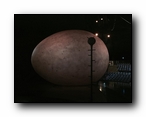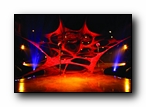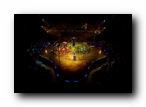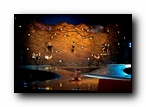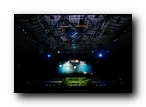
![]()

[ You are here: Grand Chapiteau | Creations | OvO | Scénographie ]
Création
Expérience
RetiréOdyssey
When Deborah Colker received a call from Cirque du Soleil she was surprised, and didn't quite understand their reason for calling. "I said, 'you want me to choreograph a show? What is it exactly?' And [Gilles Ste-Croix] said, 'no, no, no, we want you to create a show for us!' [In 2007], they told me the subject: Guy [Laliberté] wanted a show about nature, about biodiversity, and that’s it. Oh, and it needed to be in the tent. He told me, 'You must do a great show,' and that he was very excited. He said, 'Usually this show will stay around the world for 15 years, and it's for grandmothers, grandfathers, adults, children, everybody and every different culture.' I said, 'OK, I have to think about it.'" She returned to Brazil, her home, and began to brainstorm on the insect world because of a perceived relationship between acrobats and insects: "I thought, oh, insects have many legs, and the acrobats, they’re not normal human beings. It’s like they have more legs, more arms than everybody. Acrobats really can fly, climb walls, they can jump, they can walk down the floor. And with this, I really began the idea of OVO."
The overall setting is a stylized habitat that is home to the insects. At times it is a forest, at other times, a cave – or it could even be a house. Gringo’s objective was to create an organic environment that could lead to many other places. The show starts with a gigantic egg on stage, obscuring much of the performance space from view. (The Egg, which is inflatable, measures 28 ft wide by 22 ft tall.) The mysterious object from the outside world is an inexplicable enigma in the eyes of the insects (and a nod to the monolith from the Kubrick film 2001). This timeless symbol of fertility and regeneration reappears in other forms later in the show, laid by the insects. The largest set element is the Wall, which is set against the rear of the stage. The performers climb on it, disappear into it and use it as a stage, a platform and a launching pad. The Wall measures 60ft wide by 20ft tall and is made of just two moveable components. It is supported only on the sides to allow a floor with built-in trampolines to slide in and out like an enormous drawer. At first, the Wall is concealed by two enormous “skins” designed to create a sense of depth (the larger of the two skins measures 75-feet wide by 50-feet tall), and, through holes and openings, to reveal its secret life as a home to the insects as each of the skins are removed in turn. When revealed you’ll discover that there are almost no straight lines to be found anywhere in the set. True to the organic inspiration of the show, the Wall is curved, and so is the stage. But there is one exception: the Spider’s Web. Real spiders’ webs are made up of straight lines, so this is a case where art imitates life with a nod towards geometry. It is made of strong woven synthetic straps. An enormous 20-ft mechanical flower also appears on stage at various times. The flower blooms and becomes much more than an over-scale prop; it’s a character in the show. Part sculpture, part puppet, part robot, it is seen from the insects’ point of view as a towering, inspiring (and carnivorous!) feature of their environment. Other fauna are found in this world too: three long poles weighing 80lb evoke dandelion stalks. Their spines allow artists to climb them like ladders and appear at various levels above the stage, and there are human-powered self-propelled seeds that move around the stage. For the arena tour, which began in early 2016, OVO's stage went through a metamorphosis - a completely new stage and acrobatic structure were fabricated for the arena tour, and a good portion of the original design had to be adapted for that matter. What patrons may first notice is the original wall, which originally measured 60 feet wide by 20 feet high and allowed for entry from either side only, is bigger. The new wall measures 64 feet by 30 feet tall, and if the background looks a little familiar - it should. This wall was adapted from Dralion's arena tour (which closed in early 2015). It’s also used as a giant projection surface (a close-up of a leaf is projected during the hand-balancing act, for example). These projections largely replace the skins that were originally strewn across the curvaceous stage, which also went through a conversion; it is now completely round and made up of 225 individual panels for ease of installation.
Warm, colorful lighting by Eric Champoux helps create a wonderful world of kinetic, acrobatic ‘insects’ living under the big top in OVO. As this was Eric Champoux’s first show with Cirque du Soleil, challenges for him were abound, as he was more used to traditional stages with large numbers of electrics that pulsed with a lot of power. “With just four masts, the cupola, and the touring towers... there were restricted lighting positions [for me],” Champoux’s said. “But the second surprise came from the fact that the majority of the hanging points belong to the rigging department,” he lamented. Just so because there are dozens of cables that have to run around the masts and in the cupola to create the performance style embraced by Cirque du Soleil. In order to solve these problems Champoux felt he would need to have a grid. “So I duplicated the shape of the cupola and enlarged it in order to be lower and larger than the original cupola,” he said. In doing so, however, a new challenge cropped up: he had to leave the central aerial space free for a flying act. “Since I had to greatly reduce the number of sources on the masts, I opted for a design based almost entirely on moving lights.” Which he feels has created a design with more naturalistic, warm, and colorful lighting for the show. Champoux worked with a lot of images inspired of nature to achieve this effect. “At first, we wanted the entire performance to take place within the space of 24 hours, and we wanted to recreate the changing light of day… under the grass, under the water, in the fog, etcetera. So I disciplined myself to follow the logical order of things,” Champoux said. “I created a photo dossier and storyboards for each moment of the day, and for each number. I even went as far as completely redoing the lighting for a number simply because it was moved in the order of the show, and I was worried about keeping the time of day in the right order.” His assistant regularly kept him in the right time frame during these moments of intense creation, by showing him the images in a timeline for the show. And that worked... “Right up to the moment where I let myself be carried away by the bright, bold colors that surround us, when I realized that the color of nature does not come from the light, but from living beings and objects.” Champoux realized that the green of the forest did not come from the light, but from each of the leaves on each of the trees; the blue of a lake is the reflection of the sky through light; the bright orange or clear mauve of the clouds at sunset are not created simply by the light, but also by the layers of gas that live between the clouds and the sun. “From that moment on, I started to create my images differently. I found the key to what I was looking to reproduce. Using lights and artificial colors, I wanted to reproduce the exuberance of the entire biosphere.” Considering the space restrictions, he opted for a rig of moving lights with a few conventionals. For the wash units he used 22 Martin TW1 Tungsten fixtures, since he didn’t want to lose the warmth in the lamps. And since he loves the light of a standard PAR64, he wanted a wash that would marry perfectly with my PAR64s with color scrollers. “Five wash units per mast, and two on the floor.” As for the spot fixtures, he chose 15 Martin MAC700s, a fixture that already proved itself on Kooza in 2007. There are two units per mast, two on the floor, and five in the grid. Each of the wash and spot fixtures was programmed in 50 different positions to allow me maximum freedom. “As I also needed to move to the next scene in a fluid manner, I added a complete backwash of PAR64s with scrollers that blend nicely with the TW1s, and provide a unified point of view,” Champoux added. The conventionals also comprise a lot of ETC Source Fours with gobo patterns for the double layer of Skins (scenic fabric) and for all the aerial positions. To light the fabric of the Big Top behind the scenic wall, he used 5kW Fresnels with scrollers to be able to work against a backdrop of color. “By doing so, I used the tent as a cyclorama in a traditional theatre. I also used approximately 185 G2-LED RGB units as footlights around the stage and also at the foot of the wall, to help light the skins, add color to the wall, and pick out the characters that live under the skins.” There are also about 15 LDDE SpectraWOW DMX-controllable LEDs with color mixing system... “small, luminous jewels, powerful and easy to use, which are built into the Wall to simulate luminescent insect eggs.” He also used a lot of foliage gobos and breakup patterns, as well as other textures taken from nature, to light the insect-like costumes of OVO. “[I used] a lot of spider web gobos for the number ‘Web’. This was a great number to work on as there was already an immense white spider web under the Big Top and I added dozens of spider web gobos, layering texture upon texture.” Slackwire posted a challenge since the artist was extremely demanding in terms of safety for his act. “I like the depth of the colors on the Wall, with the acrobat floating in the air on his wire, and the structure that holds the wire moving up and down. At first I wanted to follow the artist with a followspot, but his position and the position of the aerial structure meant that he was completely blinded, and with the ‘ups and downs,’ it was far from being easy to cover him in a traditional way.” So he used four MAC700s at the tops of the masts. The board operator moves these manually between a low position and a high position. This allows the artist total freedom of movement. “I find that this number comes closest to my eye as a painter, in its colors, its structure, and the way the light hits the body and the objects.” “The costume designer, Liz Vandal, did incredible work, ”Champoux acknowledged. “All of the costumes are extremely vibrant and easy to light. The colors are so lively and the fabrics very rich.” * * * And what of the Brazilian vibe that spices OVO? "I didn’t think, 'Oh, I will create something Brazilian' or 'I want to make this show a Brazilian show,'" said Colker. "I didn't use any folklore, I didn’t use any labels, any Brazilian codes. I didn't think about Brazil, but I am Brazilian. My experiences are here, my background is Brazilian, my breathing is Brazilian, my inspiration is Brazilian." |


